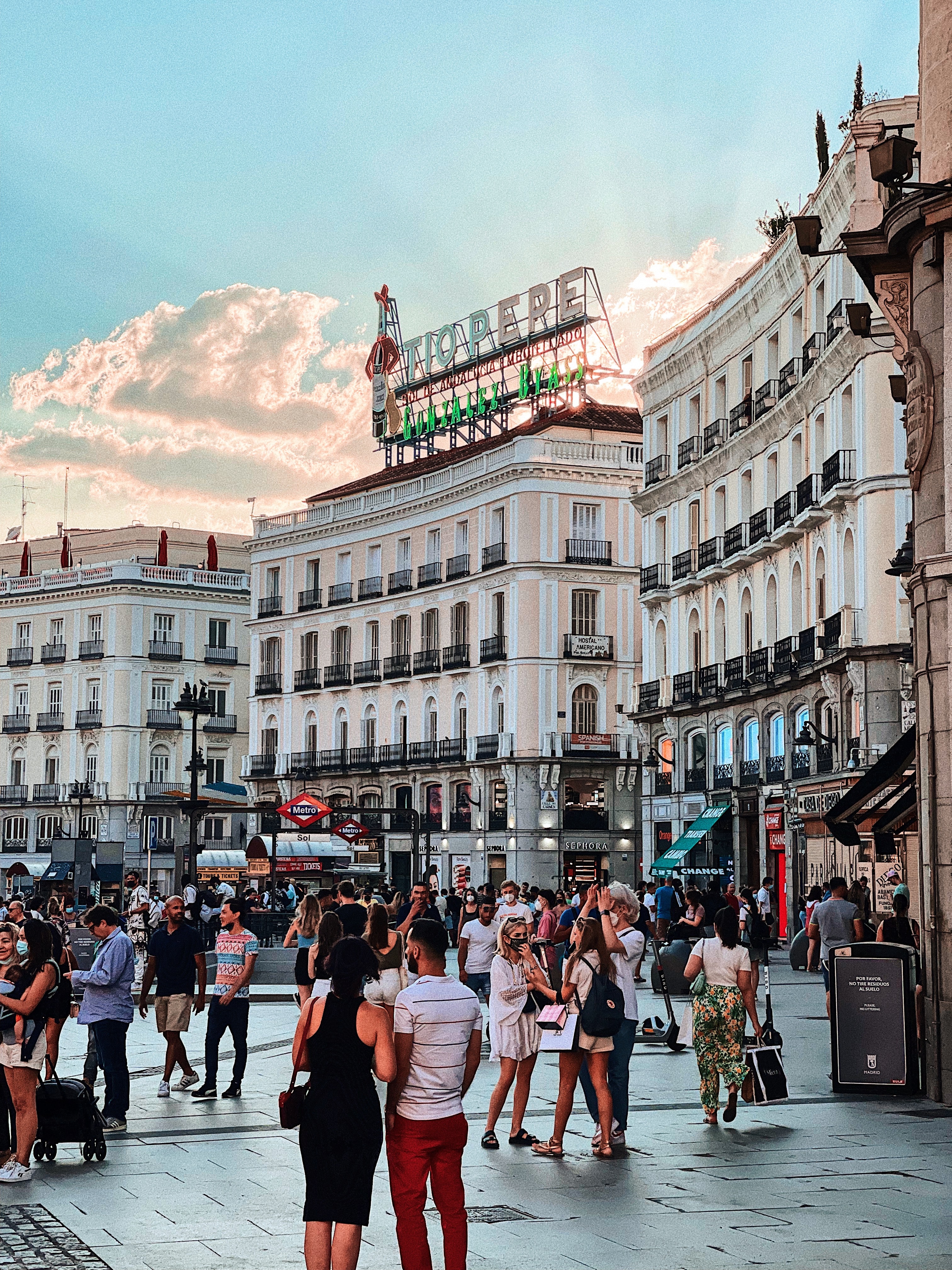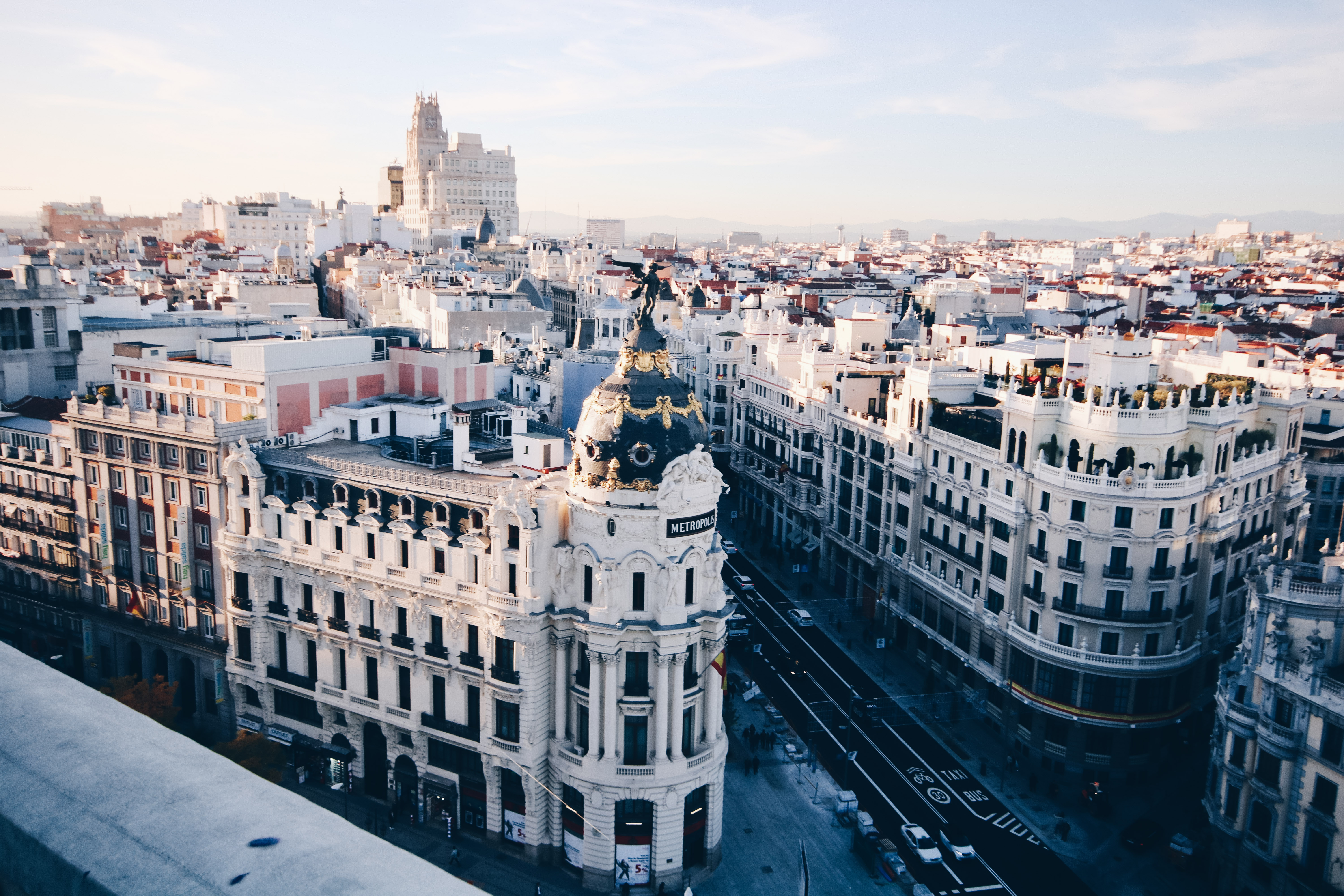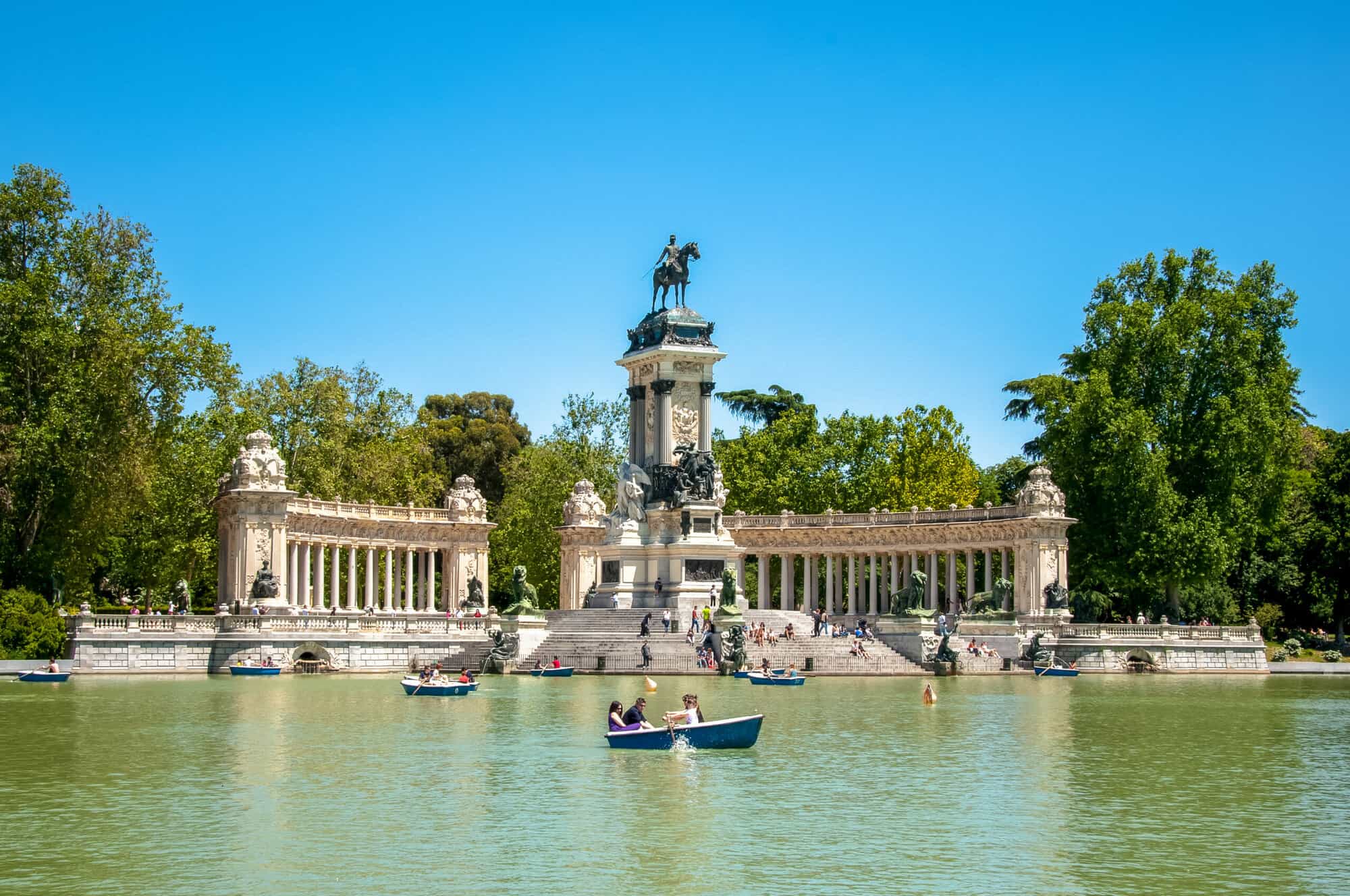If you did a survey of “Things people save up money for”, chances are vacations would be in the top three, behind buying a home or having children. This goes double for holidays in Western Europe, where prices can easily climb without careful planning. Not so in Madrid. Indeed, for tourists whose wallets are feeling a little bit light these days, Spain offers a welcome respite from the sky high prices of Paris and London. Though it’s always possible to splurge if you want to, thrifty travelers to the Spanish capital will breathe a sigh of relief when they spot the city’s reasonable prices.

Couple looking over Central Madrid. Source: Unsplash
Madrid offers a wealth of affordable options for tourists that don’t sacrifice quality for low prices. From budget-friendly accommodations and cheap eats to free attractions and unlimited public transportation, there are plenty of ways to enjoy the city on a shoestring budget. Madrid’s rich cultural heritage and dynamic atmosphere make it a top destination for budget travelers looking to stretch their euros as far as possible. So, whether you’re backpacking through Europe or just looking for a budget-friendly city break, Madrid is the perfect destination for those who want to experience the best of Spain without splurging.
How to get to Madrid
Madrid, as the capital of Spain, is well connected to the rest of the country and to Europe in general, so it’s possible to get there using all normal means of transportation – planes, trains and automobiles here. Madrid is an inland capital, chosen in part for its strategic location in the center of Spain, which made for convenient travel to virtually all parts of the mainland.
Taking a flight to Madrid is by far the most popular option for international travelers to Spain. If you’re traveling from another part of Europe, flights are usually the most convenient and quickest way to get to the Spanish capital. Another option is to travel to Madrid by train. This option is best if you’re starting in a nearby country or adding Madrid to your Eurail adventure. Finally, there’s always the humble bus – the old faithful of mass transit. If you’re not starting from the opposite side of the continent, taking a bus to Madrid is almost always the cheapest option, but it generally takes the most time.
How to get to Madrid’s city center from Madrid-Barajas Airport
There are numerous ways for visitors to Madrid to get to and from the nearby airport. Line 8 of the metro provides a direct connection from the city center to the airport. The journey from Madrid’s main center takes about 30 minutes. Another option is to take a 24/7 bus from Madrid-Barajas Airport to Madrid city center, which has the benefit of running at all hours. There are also accessible private transports and taxis.
How to get around Madrid on a budget
Despite its status as the capital of Spain and as a very cosmopolitan city, it’s easy to get around Madrid without spending a lot of money. The city’s public transportation infrastructure is comprehensive, efficient and affordable, and includes buses, metro lines and suburban trains. For most visitors to the Spanish capital, a simple metro ticket will be enough: a single ride costs about USD 1.60 USD (EUR 1.50), and you can save money by booking a pass for one or multiple days.
A great option for budget-conscious travelers is a Tourist Ticket (also known as a Tourist Travel Pass). These special tickets can be purchased pretty much anywhere you can buy a regular metro pass and allow for unlimited travel on all types of public transport within the region of Madrid. You simply buy the pass for the number of days you’ll be staying in Madrid and select which metro regions you’d like it to cover, and you can travel to your heart’s content.
Bike rental is also another great way to get around Madrid. The city is well stocked with bike sharing centers, allowing you to hop on and off as much as you like, just leaving the bike behind when you’re finished with it. The city may not be Amsterdam, but biking around Madrid is still a popular way for locals to get around, especially in the quieter neighborhoods that surround the city center.
Trains, bikes and buses – that’s all well and good. But if you ask us, Madrid is best experienced on foot. As we’ll see, most of Madrid’s popular attractions are packed into the relatively compact city center and are reachable in less than 15 minutes’ walk at a moderate pace. But really, even the convenience isn’t the point. The point is that by walking, you experience one of the things that makes being a tourist in Spain so great – the life in the streets. So we urge you: take a stroll, look around, stop and have a nice coffee, and watch the world go by! You never know what you’ll find, and the best part – it won’t cost you a penny!

View of Plaza Mayor, Madrid. Source: Unsplash
Fun and free things to do in Madrid
One great option for budget travelers is a self-guided tour of the city. With a map and a sense of adventure, you can hit a big chunk of Madrid’s most famous landmarks and attractions, such as Retiro Park, Puerta del Sol and the Royal Palace, stopping for coffee and cañas (small beers) as you please along the way. If you prefer a bit more structure, it’s still possible to take a tour without spending much money. You can also take advantage of several tour operators who offer free guided tours of the city. These are usually led by university students and offer an enthusiastic, lively guided tour experience. But please, if you do this, remember to tip your guide! They just saved you a lot of money booking a normal tour, so it’s the least you could do.
Attend a Madrid flamenco show
One of the best ways to get acquainted with Spanish culture is to attend a flamenco show. That sounds fancy and expensive, and it can be, but we’ve got a hot tip for you: an (almost) flamenco show. Do some searching, and you’ll find authentic flamenco performances taking place almost every night somewhere in Madrid. Some charge entry, some are free with purchase of a drink or meal, some are just plain old free – the point is, a flamenco show is a great way to get acquainted with another side of Spanish culture at a steep discount.
Explore the city’s parks and gardens
Madrid is home to some of the most beautiful parks in Europe. These parks offer a chance to get a little bit of peace and quiet in the big city – and with over 40 of them, there’s always one just around the corner. One of the most central and popular parks in Madrid is Parque de El Retiro, which offers a range of activities. You can rent a boat and row around in the artificial lake, have a low-cost picnic in the grass with produce from a local market, or simply stroll through the gardens and admire their beauty. There are also several landmarks that you can visit for free – including UNESCO World Heritage Site Palacio de Cristal, a massive, ornate greenhouse originally constructed to showcase exotic flora and fauna from the Philippines, then a Spanish colony. It’s now used to house art and photography exhibitions, but we have to say that the edifice itself is at least as beautiful as the art inside. Entry is free.
If you’re looking for something more outdoorsy, Casa de Campo is for you. Casa de Campo is a massive park, more than five times the size of New York’s Central Park, and home to much more varied terrain. Here, you’ll find hiking, bike trails and even horseback riding. There’s also an amusement park with roller coasts, a massive public swimming pool, the Madrid Zoo and a cable car ride that offers stunning views of the Spanish capital.
Another great park is the Parque de El Capricho. This park is located in the northeast of Madrid and is one of the city’s hidden outdoors gems. The park’s beautiful gardens are a highlight here, with an incredible variety of exotic and local plants arranged in artistic ways, interspersed in the Spanish style with fountains and statues. Inside the park, visitors can find the Palace de los Duques de Osuna, an 18th-century neoclassical palace that now houses an exhibition providing insight into the region’s history. The park also has a lake, an “exotic” garden and a labyrinth (if you have kids, they will love this one). It’s a wonderful location for a leisurely stroll, a picnic or just to soak in the breathtaking scenery.
Another park that shouldn’t be missed is the Parque Juan Carlos I. This is a large park in the northeast of Madrid named after the former king. The park has a large lake where you can rent a row or pedal boat and enjoy the tranquil surroundings. The park also has several walking paths that are perfect for a leisurely stroll, as well as bike lanes for those who prefer to ride. In addition, the park hosts several events throughout the year, including music festivals, sporting events and cultural exhibitions. It’s a great place to spend a day enjoying nature and the outdoors.
Madrid’s free museum entry
Many of Madrid’s museums offer free entry if you attend at a certain time. Keep in mind that these times are widely publicized and the museums are likely to be very full, especially during high tourist season. We recommend arriving early so you can line up ahead of time and make sure you get inside. Some attractions may require you to book your tickets in advance or have a limited number of free tickets available, so it’s a good idea to check the attraction’s website or call ahead to confirm. Here’s a non-comprehensive list of museums and the times they offer free entry.
How to get free entry to museums in Madrid:
- Museo Nacional del Prado: the Prado Museum is one of the most important art museums in the world, with a collection that includes masterpieces by Goya, Velázquez and El Greco. The museum offers free entry Monday to Saturday from 6:00 p.m. to 8:00 p.m., and on Sundays and holidays from 5:00 p.m. to 7:00 p.m.
- Museo Nacional Centro de Arte Reina Sofía: the Reina Sofía Museum is another popular art museum in Madrid, with a focus on contemporary and modern art. The museum offers free entry Monday to Friday from 7:00 p.m. to 9:00 p.m., and on Saturdays from 2:30 p.m. to 9:00 p.m., and on Sundays from 10:00 a.m. to 2:30 p.m.
- Palacio Real de Madrid: the Royal Palace of Madrid is a stunning building with 3,000 rooms, many of which are open to the public. The palace offers free entry Monday to Thursday from October to March, and on Wednesdays from April to September, from 4:00 p.m. to 6:00 p.m.
- Thyssen-Bornemisza Museum: the Thyssen-Bornemisza Museum is a private art collection that was turned into a museum, and it houses an impressive collection of European art from the 13th to the late 20th century. The museum offers free entry on Mondays from 12:00 p.m. to 4:00 p.m.
- CaixaForum Madrid: CaixaForum Madrid is a cultural center that hosts a variety of exhibitions, concerts and events. The center offers free entry on Mondays from 10:00 a.m. to 8:00 p.m.

View of central Madrid from above. Source: Unsplash
Culture and food all at once: Madrid’s fabulous markets
Another great, free cultural activity in Madrid are its famous markets, or mercados. These markets came into existence hundreds of years ago as the sites of weekly markets for produce and meat, but over time they became cultural institutions. Now they’re an activity and tourist attraction even for people who aren’t planning on doing any shopping!
The most famous market by far is the Mercado de San Miguel. Like many of these markets, it started as a food market, and today still functions ostensibly as such. Visitors to the Mercado de San Miguel can find a wide variety of stalls selling everything from fresh seafood to cured meats to artisanal cheeses. The market is located in a historic glass building, and it’s a great place to sample traditional Spanish cuisine. Some of the specialties at the market include oysters, jamón ibérico and vermouth.
Getting to the Mercado de San Miguel
To take the Madrid metro to Mercado de San Miguel, take line 1 or line 5 and exit at either the Ópera or Sol station.
Another beloved market is the El Rastro. If Mercado de San Miguel is a classic food market, this is a classic flea market. At El Rastro, you can expect to find a lively atmosphere and an eclectic mix of goods for sale, from vintage clothing to antiques and jewelry, as well as small trinkets and souvenirs. It’s a great place to hunt for unusual and unique items to remind you of your time in Madrid.
Getting to El Rastro
To take the Madrid metro to El Rastro, take line 5 and exit at either La Latina or Puerta de Toledo station.
The Mercado de Motores is a monthly market that takes place in the Museo del Ferrocarril, a historic train station in the Arganzuela neighborhood, so it’s also good for some interesting sightseeing. The market features a mix of vintage and modern goods, including clothing, accessories and home décor. It’s a great place to find one-of-a-kind items and to enjoy live music, food and drink.
Getting to Mercado de Motores
To take the Madrid metro to Mercado de Motores, take line 1 and exit at Tribunal station, then transfer to line 10 and exit at Legazpi station.
Cheap accommodation in Madrid
Madrid has no shortage of affordable hotels and hostels for those looking for a comfortable, clean place to stay without breaking the bank. In fact, many of these hostels can be downright fun places to stay the night!
- Hostel One Madrid:
C. del Montserrat, 9, 28015 Madrid, Spain
Hostel One Madrid is a popular hostel located in the city center, near the Gran Vía and many other attractions. The hostel offers affordable dormitory-style rooms and a friendly atmosphere, with common areas for socializing and meeting other travelers.
- Safestay Madrid:
C. de Sagasta, 22, 28004 Madrid, Spain
Safestay Madrid is another popular hostel in the city center, near the Puerta del Sol and the Plaza Mayor. The hostel offers both dormitory-style and private rooms, and it has a rooftop terrace with great views of the city.
- Hotel Life:
C. de Pizarro, 16, 28004 Madrid, Spain
Hotel Life is an affordable and centrally located hotel in the Salamanca neighborhood, just a few minutes’ walk from the Retiro Park. The hotel offers modern and comfortable rooms, with amenities like free Wi-Fi, air conditioning and a buffet breakfast. It’s a great option for travelers who want to be close to the action but still enjoy a bit of peace and quiet.
